INSTITUT SUPERIEUR D'ANTHROPOLOGIE
INSTITUTE OF ANTHROPOLOGY
ONLINE COURSES / COURS A DISTANCE
OPEN COURSE : FEBRUARY 2013
HRM 104 : INTRODUCTION TO INTANGIBLE CULTURAL HERITAGE
REGISTER NOW
ISRAËL – 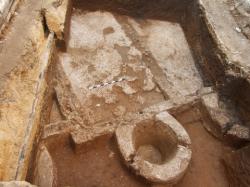 Yafo - Recently impressive remains of an industrial installation from the Byzantine period which was used to extract liquid were exposed on Hai Gaon Street. Installations such as these are usually identified as wine presses for producing wine from grapes, and it is also possible they were used to produce wine or alcoholic beverage from other types of fruit that grew in the region. Yafo’s rich and diverse agricultural tradition has a history thousands of years old beginning with references to the city and its fertile fields in ancient Egyptian documents up until Yafo’s orchards in the Ottoman period. According to Dr. Yoav Arbel, director of the excavations on behalf of the Israel Antiquities Authority, “This is the first important building from the Byzantine period to be uncovered in this part of the city. The fact that the installation is located relatively far from Tel Yafo adds a significant dimension to our knowledge about the impressive agricultural distribution in the region in this period. The installation, which probably dates to the second half of the Byzantine period (sixth century – early seventh century CE), is divided into surfaces paved with a white industrial mosaic. Due to the mosaic’s impermeability such surfaces are commonly found in the press installations of the period which were used to extract liquid. Each unit was connected to a plastered collecting vat. The pressing was performed on the mosaic surfaces whereupon the liquid drained into the vats. It is possible that the section that was discovered represents a relatively small part of the overall installation, and other elements of it are likely to be revealed in archaeological excavations along adjacent streets which are expected to take place later this year”.
Yafo - Recently impressive remains of an industrial installation from the Byzantine period which was used to extract liquid were exposed on Hai Gaon Street. Installations such as these are usually identified as wine presses for producing wine from grapes, and it is also possible they were used to produce wine or alcoholic beverage from other types of fruit that grew in the region. Yafo’s rich and diverse agricultural tradition has a history thousands of years old beginning with references to the city and its fertile fields in ancient Egyptian documents up until Yafo’s orchards in the Ottoman period. According to Dr. Yoav Arbel, director of the excavations on behalf of the Israel Antiquities Authority, “This is the first important building from the Byzantine period to be uncovered in this part of the city. The fact that the installation is located relatively far from Tel Yafo adds a significant dimension to our knowledge about the impressive agricultural distribution in the region in this period. The installation, which probably dates to the second half of the Byzantine period (sixth century – early seventh century CE), is divided into surfaces paved with a white industrial mosaic. Due to the mosaic’s impermeability such surfaces are commonly found in the press installations of the period which were used to extract liquid. Each unit was connected to a plastered collecting vat. The pressing was performed on the mosaic surfaces whereupon the liquid drained into the vats. It is possible that the section that was discovered represents a relatively small part of the overall installation, and other elements of it are likely to be revealed in archaeological excavations along adjacent streets which are expected to take place later this year”.
http://www.antiquities.org.il/article_Item_eng.asp?sec_id=25&subj_id=240&id=1985&module_id=#as
NEPAL – 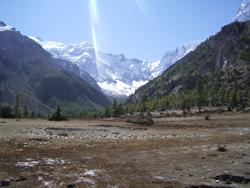 Himalaya - A team of archaeologists from the University of York are to travel to the roof of the world to discover, survey, and record mountain archaeology in the Nepalese Himalayas. The Himalayan Exploration and Archaeological Research Team (HEART) will spend four weeks documenting high-altitude artefact scatters, rock shelters and formerly inhabited hand-cut cave systems that were used either as settlements or tombs dating back to the 3rd century BC. The five-strong team, led by Dr Hayley Saul, of the Department of Archaeology at York, will be based in the Mustang valley in the Annapurna massif where they will use digital 3D imaging to survey and record the features as part of a new initiative to piece together the prehistory of the high Himalayas. They will also trace the way mountain cultures have occupied and adapted to the landscape through time, seeking to set Himalayan archaeology in a broader global framework. This will include the role of the region in the development of the domestic cultivation of rice, a historical perspective on mountain resource exploitation, and the spread of Buddhism.
Himalaya - A team of archaeologists from the University of York are to travel to the roof of the world to discover, survey, and record mountain archaeology in the Nepalese Himalayas. The Himalayan Exploration and Archaeological Research Team (HEART) will spend four weeks documenting high-altitude artefact scatters, rock shelters and formerly inhabited hand-cut cave systems that were used either as settlements or tombs dating back to the 3rd century BC. The five-strong team, led by Dr Hayley Saul, of the Department of Archaeology at York, will be based in the Mustang valley in the Annapurna massif where they will use digital 3D imaging to survey and record the features as part of a new initiative to piece together the prehistory of the high Himalayas. They will also trace the way mountain cultures have occupied and adapted to the landscape through time, seeking to set Himalayan archaeology in a broader global framework. This will include the role of the region in the development of the domestic cultivation of rice, a historical perspective on mountain resource exploitation, and the spread of Buddhism.
http://www.york.ac.uk/news-and-events/news/2013/research/himalayan-exploration/
ROYAUME UNI – 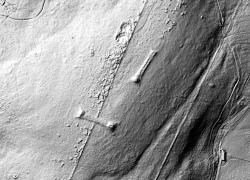 Caithness - Over 300 new archaeological sites have been found in Caithness – some dating back 3000 years – in a survey which is “beginning to rewrite the history of northern mainland Scotland”. The work was carried out using a technique know as Light Detection and Ranging (LiDAR) which uses a laser to scan the ground from an aeroplane. The survey was commissioned by Baillie Windfarm Ltd after it was required to record the landscape surrounding the nationally significant cluster of Neolithic chambered cairns at Hill of Shebster. The company asked AOC Archaeology Group to carry out the work. The main focus of the survey was Cnoc Freiceadain, a prominent shoulder rising above the northern coast of Caithness, which is the site of a spectacular group of Neolithic monuments, including two long cairns and a series of stone settings.
Caithness - Over 300 new archaeological sites have been found in Caithness – some dating back 3000 years – in a survey which is “beginning to rewrite the history of northern mainland Scotland”. The work was carried out using a technique know as Light Detection and Ranging (LiDAR) which uses a laser to scan the ground from an aeroplane. The survey was commissioned by Baillie Windfarm Ltd after it was required to record the landscape surrounding the nationally significant cluster of Neolithic chambered cairns at Hill of Shebster. The company asked AOC Archaeology Group to carry out the work. The main focus of the survey was Cnoc Freiceadain, a prominent shoulder rising above the northern coast of Caithness, which is the site of a spectacular group of Neolithic monuments, including two long cairns and a series of stone settings.
http://www.johnogroat-journal.co.uk/News/Aerial-survey-unearths-300-historic-sites-19022013.htm
TURQUIE – 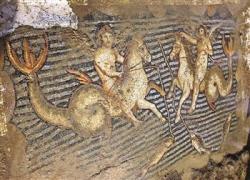 Yumurtalık - A mosaic featuring an Eros figure fishing on horse has been found in the southern province of Adana’s Yumurtalık district. The half fish-half horse Eros, which is called Hippocampus in Greek mythology, is claimed to be the one and only such mosaic in the world. Made up of marble, glass and stone, the mosaic is estimated to date back to the late Roman or early Byzantine era. The Adana Museum Directorate has initiated archaeological excavations in the region where the mosaic was discovered. One week ago the existence of a villa was determined in the area. The villa was thought to be owned by a top state official and the Eros mosaic was revealed when a part of the villa was excavated. Yumurtalık Deputy Mayor Erdol Erden said the Eros mosaic was found during a one-week excavation. “We found young and adult Eros figures in the villa. Experts say that these figures were the first and only such figures in the world,” Erden said.
Yumurtalık - A mosaic featuring an Eros figure fishing on horse has been found in the southern province of Adana’s Yumurtalık district. The half fish-half horse Eros, which is called Hippocampus in Greek mythology, is claimed to be the one and only such mosaic in the world. Made up of marble, glass and stone, the mosaic is estimated to date back to the late Roman or early Byzantine era. The Adana Museum Directorate has initiated archaeological excavations in the region where the mosaic was discovered. One week ago the existence of a villa was determined in the area. The villa was thought to be owned by a top state official and the Eros mosaic was revealed when a part of the villa was excavated. Yumurtalık Deputy Mayor Erdol Erden said the Eros mosaic was found during a one-week excavation. “We found young and adult Eros figures in the villa. Experts say that these figures were the first and only such figures in the world,” Erden said.
http://www.hurriyetdailynews.com/eros-mosaic-found-in-southern-turkish-city.aspx?pageID=238&nID=41523&NewsCatID=375
PAPOUASIE - One media release announced the findings of research that had been carried out by Jean-Michel Chazine, of the French National Centre for Scientific Research (CNRS - France). He had been approached by divers who had been exploring in the ocean, off the coast of West Papua. They had found some remarkable examples of rock art painted onto the face of cliffs which had started to slip under the ocean. In his statement, Jean-Michel Chazine expounded on the unique parameters in that area which had to be present before any rock art could be expected to be found. These parameters are the presence of a large, high cliff; a cave or cavity at the base of the cliff; a step-bank at the base of the cliff; a coloured strip flowing down towards the entrance of the cave or cavity. Remarkably, if one or more of these parameters were missing then no rock art would be found.
http://www.stonepages.com/news/archives/004965.html
CANADA – 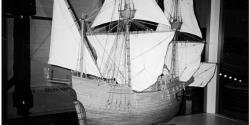 Red Bay - t’s the oldest shipwreck ever found in Canada and one of the most important in the world: a 16th-century Basque whaling galleon that lies at the bottom of Labrador’s Red Bay, a sunken relic from the Age of Discovery that symbolizes the early spread of European civilization — and commerce — to the New World. Now, the 450-year-old San Juan, a jumble of thick beams and broken barrels lying in shallow waters off the site of a 1560s-era whaling station in the Strait of Belle Isle, is to be resurrected by a team of Spanish maritime heritage experts planning to construct a full-scale, seaworthy replica of the original 16-metre, three-masted vessel. Parks Canada underwater archeologists, who discovered the 250-tonne San Juan in 1978 after following documented clues about a lost galleon traced by federal archivist Selma Barkham, will meet this week with Spanish officials to begin sharing decades of amassed research on the ship’s design and construction, Postmedia News has learned.
Red Bay - t’s the oldest shipwreck ever found in Canada and one of the most important in the world: a 16th-century Basque whaling galleon that lies at the bottom of Labrador’s Red Bay, a sunken relic from the Age of Discovery that symbolizes the early spread of European civilization — and commerce — to the New World. Now, the 450-year-old San Juan, a jumble of thick beams and broken barrels lying in shallow waters off the site of a 1560s-era whaling station in the Strait of Belle Isle, is to be resurrected by a team of Spanish maritime heritage experts planning to construct a full-scale, seaworthy replica of the original 16-metre, three-masted vessel. Parks Canada underwater archeologists, who discovered the 250-tonne San Juan in 1978 after following documented clues about a lost galleon traced by federal archivist Selma Barkham, will meet this week with Spanish officials to begin sharing decades of amassed research on the ship’s design and construction, Postmedia News has learned.
http://o.canada.com/2013/02/18/canadas-oldest-shipwreck-to-be-resurrected-in-replica-of-16th-century-basque-galleon/